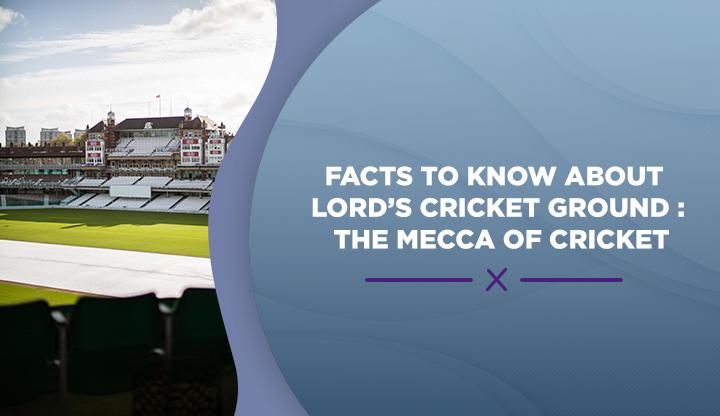Facts to Know About Lord’s Cricket Ground: The Mecca of Cricket

The official home ground of the England cricket team, the Lord’s Cricket Ground is an international cricket stadium in London. Established more than two centuries ago in 1814, the stadium is regarded as the spiritual home of cricket by almost every cricket fan.
While almost everyone has heard of the Lord’s Cricket Ground, its fascinating history is unknown to many cricket fans. As such, we’ve created an article that lists some of the most interesting facts about the cricketing venue. Keep reading!
Today’s Lord’s cricket ground is not the original Lord’s
It’s not quite well known that Thomas Lord, the founder of the Lord’s Stadium, originally established three cricket grounds. And the grounds that we know today are actually the third of the three. Thomas Lord’s first venue was where Dorset Square is now located. The original venue was used for cricketing events until 1810, when some disputes over the rate of rents resulted in the relocation of the stadium.
The second Lord’s Cricket Ground, the official home of the Marylebone Cricket Club between 1811 and 1813, was located on part of Lisson Green Estate. The second ground, which was in proximity to the original site, was repossessed by the authorities during the construction of the Regent’s Canal. The present grounds were finally built by Lord with his compensation money in 1814.
It houses the world’s oldest sporting stadium
Another interesting thing about the stadium is that it houses the oldest sports museum on the planet, the Marylebone Cricket Club (MCC) museum. The MCC museum was constructed by the Duke of Edinburgh in 1953, but its collection dates back to the mid-19th century.
The museum is packed with intriguing memorabilia and exhibits, which also include the original Ashes urn. The museum also boasts various bats, uniforms, and pieces of kits belonging to some of the greatest players in the history of cricket. Other materials at the MCC are related to grassroots and community clubs that paved the path for the sport’s development to its current form.
The grounds are home to the biggest selection of cricket books on the planet
In addition to the museum, Marylebone Cricket Club (MCC) also operates a sporting library. The MCC library is a highly comprehensive and interesting collection of cricket books in the world. The collection of cricket books at the MCC spans over 17,000 titles, a number that remains unmatched by any other sports museum in the world.
Being a highly dedicated cricket library, the collection at the MCC contains books, magazines, pamphlets and other rare acquisitions right from the emergence of the sport in the 18th century. On matchdays, the MCC library acts as a private library that can be accessed only by members of the cricket association. However, it is open as a reference and research facility on non-match days.
Lord’s has a sloping outfield
In terms of play, the Lord’s stadium is renowned for having a sloping outfield. As you’d be knowing, the venue features a two-and-a-half meter drop from the northwest to the southeast sides of the playing surface. The nature of the playing surface tends to affect the performance of both the batsmen and the bowlers during matchdays.
To date, many bowlers have used the deviation to their advantage, with the right-handed batsmen tending to be more affected than the left-handed ones. The outfield was also notorious for becoming too waterlogged to play on until the 2002-03 season, when the clay at the venue was replaced by sand. In the past two decades, there have been several calls from the cricketing community for the pitch to be levelled, but the MCC has deliberately avoided them by citing the reason that it will require the play to be suspended for up to five years.

The ground operates on 100% renewable energy
In 2018, Lord’s became the first cricket ground in Great Britain to run on 100% renewable energy, and it is now committed to undertaking several sustainability initiatives. Lord’s current sustainability initiatives include the launch of a reusable cup scheme, the removal of plastic straw from all its outlets, and the increase in the number of water fountains around the venue.
Lord’s newest event space, Pelham’s, is at the forefront of the ground’s sustainability drive. The venue has a rainwater recycling system and it also uses solar thermal panels to generate hot water and electricity. Furthermore, the venue also makes the most of natural light by using semi-translucent fabric roofs. Given all these initiatives, it’s no surprise that Lord’s was shortlisted for the Greenest Venue title in the Hire Space Award 2018.
Lord’s has hosted several types of sports games in its history
In addition to being a fully-fledged cricket venue, Lord’s is also home to a real tennis court. The tennis court at Lord’s is opened daily throughout the year to its members. And if non-members wish to play at the venue, they must be introduced by a present member.
Along with tennis, Lord’s has also been a host to bowl fixtures. During WWI, the venue hosted a baseball match to raise funds for social welfare causes. What’s more, Lord’s also hosted the archery competition during the 2012 London Olympics.
Lord’s is the most successful away venue for Australia
While Lord’s is the official home ground to the England cricket team, their arch-rival Australia boasts a great record here. Throughout its history, Lord’s has been the most successful away venue for Australia, with the side having won more Tests there than any other away ground.
In 2009, the English cricket team won the second Test of the 2009 Ashes series against Australia. This resulted in England breaking Australia’s record of having a continuous winning spell that spanned almost 75 years. Before their 2009 Ashes defeat at Lord’s, Australia hadn’t lost a Test match at the venue since 1934 - their only defeat of the 20th century.
Table of Content
-
Today’s Lord’s cricket ground is not the original Lord’s
-
It houses the world’s oldest sporting stadium
-
The grounds are home to the biggest selection of cricket books on the planet
-
Lord’s has a sloping outfield
-
The ground operates on 100% renewable energy
-
Lord’s has hosted several types of sports games in its history
-
Lord’s is the most successful away venue for Australia
RECENT

Champions League
Constitution Hill’s Champion Hurdle Prep Disrupted after Unsatisfactory Scope
Jan 23rd, 2024 By Ben Joseph
Premier League
Iroko’s Miracle Comeback – Cheltenham winner back in training after injury surprise
Jan 23rd, 2024 By Ben Joseph
Premier League
The Transfer Window So Far: Has Financial Fair Play Slowed Premier League Spending?
Jan 23rd, 2024 By John McMullen
Football, Premier League
Game Week 13: High-Flying Bees Host Red Hot Gunners
Nov 20th, 2023 By John McMullen
Football, Premier League
Game Week 13: Battle For Bragging Rights at St. James’ Park
Nov 20th, 2023 By Ben Joseph
Football, Premier League
Game Week 13: Title Showdown at Stamford Bridge
Nov 20th, 2023 By John McMullen
Football, Premier League
Game Week 12: Buoyant Villa Host Surging Fulham in West London Derby
Nov 10th, 2023 By Ben Joseph
Football, Premier League
Game Week 12: Can Forest Chop Down the Hammers?
Nov 10th, 2023 By John McMullen
Football, Premier League
Game Week 12: Rampant Reds Host High-Flying Bees
Nov 10th, 2023 By Ben Joseph
Football, Premier League
Game Week 12: Can Plucky Blades Clip High-Flying Seagulls’ Wings?
Nov 10th, 2023 By Ben Joseph
Football, Premier League
Game Week 12: Table Toppers Tussle as City Host Chelsea
Nov 10th, 2023 By Ben Joseph





